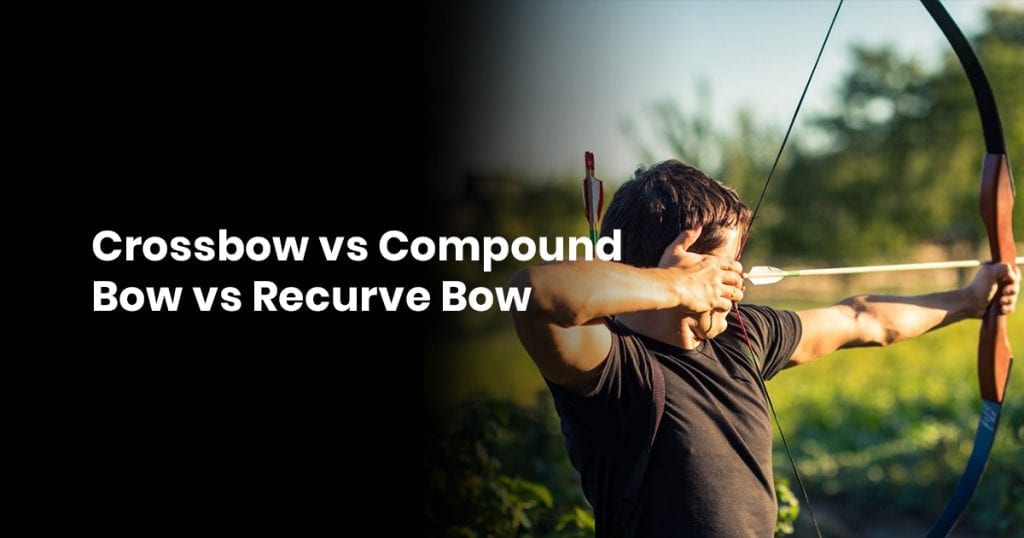The great debate in archery.
The historically powerful recurve bow, the modern compound bow, and the rapid-fire crossbow. You can’t avoid this subject when you’re a hardcore archer.
People are always asking what’s best or what they should use. The truth is, we don’t want to discourage anyone from pursuing one type of archery over another due to personal biases.
Instead, we decided to lay out a list of facts and situations where some bows may be better than others, and allow you to make the final call for yourself.
Consider this your study guide on comparing these three bow types.
If you’d like to see a graphical breakdown of the archery bow types, we got you covered:

Share This Image On Your Site
Ease of Use
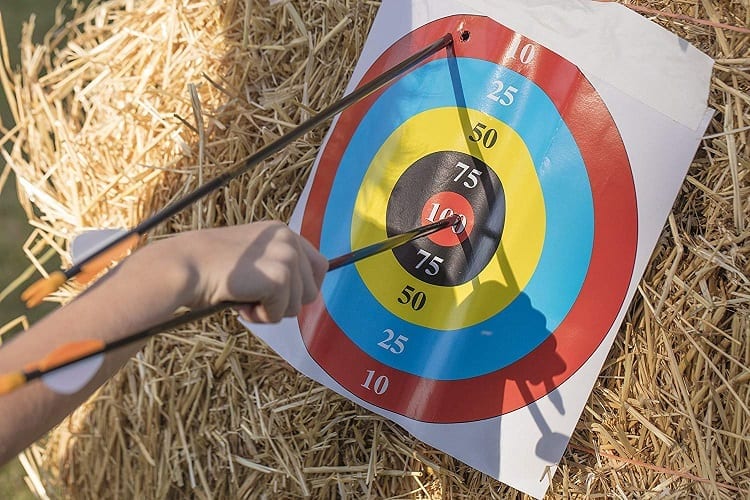
Archery isn’t easy, but some bow types are significantly harder to control than others.
There’s nothing wrong with siding with ease of use, but hardcore archers and bowmasters will often choose the more difficult challenge to have something to conquer.
There are very wide gaps in differences between these three bow types.
| Crossbow | Compound Bow | Recurve Bow |
| Crossbows were not designed to be used easily. Loading and unloading is fairly dangerous, and that means you have to spend extra time on this step. There are a lot of working parts, similar to a compound bow, so you have more hoops to jump through since this has a mechanical element to it. Safety takes longer, and while actually firing your shots is quick and effortless with a crossbow, getting there is the hard part. | Compound bows are the easiest to use, by far. You have less resistance than recurve bows, and they’re not as difficult to load up or maintain as a crossbow. Compound bows have a special property where you don’t have to put 60 lbs of pressure to get 60 lbs of draw weight; pulley systems offer a let-off, only requiring between 20-25% of your physical power to reach peak performance. | Recurves are still easier to use than crossbows. They’re easy enough to nock and release, but because of the additional power required to get a shot off, they’re just a little bit harder to use than compound bows. Using a recurve bow will build muscle though, whereas compound bows do very little to improve your physical form. Recurves are classic and currently the only ones allowed in the Olympics due to their more challenging nature. |
| Our Ease of Use Rating: 7.1/10 | Our Ease of Use Rating: 8.1/10 | Our Ease of Use Rating: 7.9/10 |
Overall, you want something that is simple enough to use, but not something that’s going to make it a breeze. Archery is supposed to have a challenging element to it, so find what challenges you, and conquer it.
Hunting vs. Competitive Practice
Each has its own benefits for hunting, but you might actually see some unexpected differences when you’re looking at the competitive aspects.
It should be noted that compound bows have not been allowed in the Olympics yet, but as of 2019, they will be in the Pan American Games for the first time, so it isn’t impossible to see them making their way to the Olympics by 2028/2032.
| Crossbow | Compound Bow | Recurve Bow |
| Do you want to take down a target? Crossbows offer immense FPS, which takes down prey in the middle of a hunt like nothing else. That being said, it’s not good for competition. It’s very mechanical, so even if you don’t possess more strength than is required to pull the string back, then you’re completely fine. You just have to be able to load is. Crossbows are not used in competitions, but if you were to host your own crossbow competition, it would be very lackluster. | Compound bows may be used to prepare for competitive archery, but are generally not used in actual competitions. The best marker of this is that the Olympics currently do not support compound bows. For hunting? Compound bows reign supreme. The quick draw weight and 75-80% let-off make these super simple to use and take down targets. Compound bows also do not have a high minimum required draw weight like crossbows do (40 lbs vs 75 lbs for hunting). | Recurves are the only bows used for competitive archery and the Olympics, and properly test your abilities as an archer. There’s a lot of forms that goes into this and a lot of physical prowess, so it’s the best marker to define where you are in your skill level. Recurves can absolutely be used in hunting, but they’re a little less viable than compound bows for the sake of draw weight let-off and time spent to nock an arrow. |
| Our Hunting Rating: 9.1/10Our Competitive Rating: 1.9/10 | Our Hunting Rating: 9.3Our Competitive Rating: 7.4 | Our Hunting Rating: 8.7Our Competitive Rating: 9.7 |
Safety
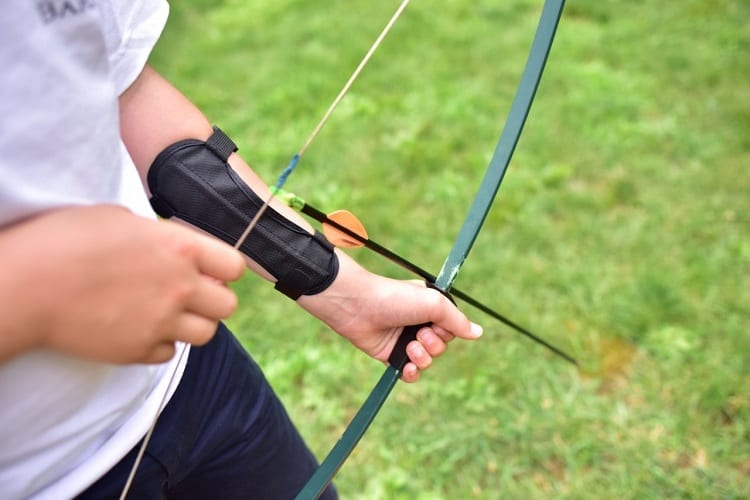
Safety is a leading concern for archers and their loved ones who aren’t performing archery themselves.
There’s a lot of misconceptions about archery safety, but this section is quick because there aren’t a lot of archery accidents to bring up.
It’s actually been proven to be safer than gun hunting, and only 10% of bow injuries occur from competitive shooting or leisure activity, with a resounding 90% occurring during hunting.
| Crossbow | Compound Bow | Recurve Bow |
| Crossbows have a trigger, just like a gun. They’re very easy to mishandle, especially if you load one up while walking around the woods to hunt and you don’t have the safety on, or your safety malfunctions (commonplace with crossbows). You’re under more stipulations when hunting if you’re using a crossbow, such as increased draw weight minimums and inspection of your safety mechanisms. | Compound bows are relatively safe to use. They are the most-used during hunting, and as a result, technically contribute to most archery-related injuries every single year. It’s a bit of an unfair look though since the number of injuries is already so small when you compare bows versus firearms. During competitive archery or target practice, these are as safe as a recurve bow, even at close range. | Recurves fully requires you to be a part of the equation. Compound bows have high let-offs and crossbows are cocked just like a pistol, but recurves are all about your strength. The only negative safety-related aspects of archery, in general, are dry firing and not checking the surrounding area of your target prior to shooting, and since recurves rely on your control and awareness, they’re incredibly safe if all other protocol is followed. |
| Our Safety Rating: 6.5/10 | Our Safety Rating: 7.6/10 | Our Safety Rating: 8.9/10 |
If you’re wondering about what bow to get your child or teenager, recurves are the way to go.
It’s a way to test their strength and actually get them close to archery and doesn’t require as much maintenance as a compound bow. Beginners should avoid crossbows until they learn how standard bows react.
Pricing
Nobody said this was going to be cheap.
Archery is vastly inexpensive compared to refilling ammunition from gun shooting hobbies and hunting, but to get started, you will need to sink a small amount of capital into your hobby.
Don’t worry; it’s not an expensive hobby to maintain once you get the ball rolling.
| Crossbow | Compound Bow | Recurve bow |
| Crossbows are among the highest cost, and for good reason: there’s a lot of mechanical elements at work. You have far more working parts on a crossbow that require much more tension, and as a result, they’re going to run you a higher total. | Compound bows and recurves usually sit around the same cost, but a jump in quality is where you’ll see a gap. Compound bows average at about 10-12% more than recurves for similar constructions and material types. | Recurves can be dirt cheap, but then again, you get what you pay for. When you climb into the top-tier quality recurves, you’ll still see a price drop compared to compounds and crossbows. |
| Our Price Rating: 6.5/10 (High Cost) | Our Price Rating: 7.2/10 (Median Cost) | Our Price Rating: 7.9/10 ( Low Cost) |
Longevity
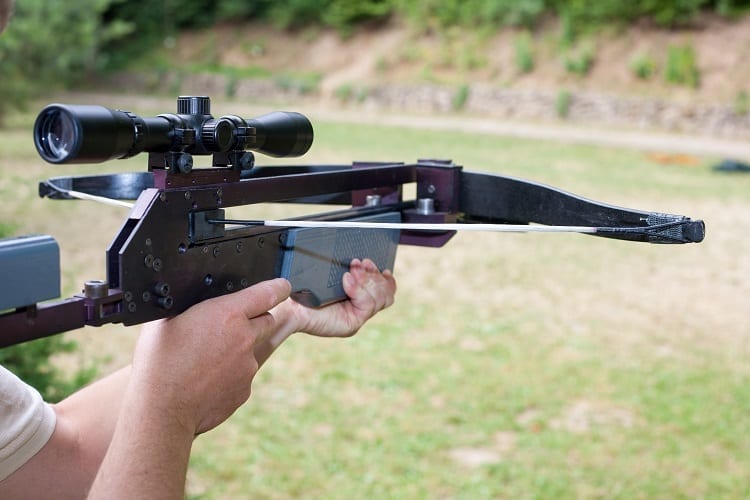
Which one’s going to last you longer?
Well, the fact is, they all have different maintenance needs which will get in the way of properly caring for each bow type.
Basically, you have to decide how dedicated you’re going to be to archery to decide which one is going to work for you, based on these maintenance and care expectations.
| Crossbow | Compound Bow | Recurve Bow |
| Crossbows are absolutely built to last you. There are more mechanical elements at play, but manufacturers account for that when they build these things. Everything is calculated from the draw weight to the pull-back limit, so you’re not going to run into problems with damaging your crossbow like you would run into with a compound or recurve. Quality materials also help. | Compound bows are set to last for a long time, but with so many working parts, you’re bound to have to replace a few here and there. They’re built for high tension, and most of them come with a mechanism in place to stop your draw when you hit a certain draw weight (the maximum or maximum that you have preset) to avoid damaging the limbs. They’re sturdy, but augmentations are subject to damage. | Recurves are set to last for a very long time as well, so long as you care for them. You need to destring at least one limb after each use, so you’re not putting unnecessary stress on the limbs while in storage. Recurves are now made out of carbon and aluminum, and often have takedown limbs for better storage capabilities. |
| Our Longevity Rating: 7.9/10 | Our Longevity Rating: 7.1/10 | Our Longevity Rating: 7.7/10 |
As far as the average lifespan goes, each of these are viable picks, you just have to account for the cost of upholding mechanical aspects versus simple takedown limbs and strings.
Injury Rates
Injuries are very few and far between in archery.
As we stated before, just 10% of archery injuries are through competitive shooting (recurves), where the other 90% are in hunting (crossbow and compound).
Even when you factor that in, you’re looking at approximately 4,300 total annual injuries in archery, compared to 28,100 annual firearm accidents.
| Crossbow | Compound Bow | Recurve Bow |
| Crossbows do not have the highest injury rating, but the injuries sustained from them tend to be far more dangerous and emergency room-worthy. Crossbows should be treated like firearms with a similar ruleset to avoid accidental injuries to yourself or others. | Compound bows account for most bow-related accidents. Our rating places them as safer than crossbows simply because you still need to pull a compound bow back; you can’t cock it like a crossbow. Compound bows are used in hunting more than any other type of bow, hence the correlation to a high number of injuries. | You couldn’t get any safer in archery than a recurve bow. They’re sized accordingly, don’t have augmentations or accessories to snag yourself off of, and have a higher threshold of physical strength to reach maximum draw weights. Children use recurves to practice archery in the United States and South Korea; they’re as safe as it gets. |
| Our Injury Rating: 3.5 (High Injury) | Our Injury Rating: 4.0/10 (High Injury) | Our Injury Rating: 9.1/10 (Low Injury) |
Safety ratings are difficult to determine, but we based this off of information available from online sources that report annual injuries as a result of bows for hunting and competitive archery.
10% of archery-related incidents are from recurves and compounds in competitive archery, while 90% are from crossbows and compounds during hunting.
FPS
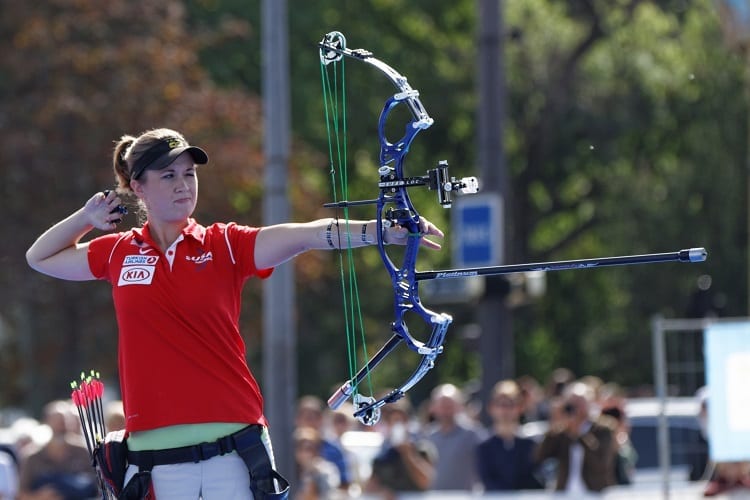
FPS stands for feet per second, as in how far the arrow can travel.
Arrow weight attributes to this, but draw weight (and how hard it is to reach that peak draw weight) are the main factors at work here.
Obviously, each of these bow types has drastically different mechanics, making some better for high FPS than others.
| Crossbow | Compound Bow | Recurve Bow |
| You can’t match a crossbow’s FPS with a compound or a recurve bow. You’ll see speeds up to about 460 FPS (rarely over this for crossbows that are sold by manufacturers), though some custom crossbows can reach upwards of 600 FPS. In our opinion, anything over 400 is just for bragging rights. 400 FPS, in hunting, will take down your prey with brutal precision. Since crossbows are meant to be used at closer ranges, this is plenty. | Compound bows have the second-highest FPS, and that’s because they’re mechanically built superior to recurve bows. With a lever and pulley system, there’s a tighter drawback that allows you to propel the arrow with about 7-9% more power than top-tier recurve bows. The main reason that the FPS is so manageable is the let-off that most compound bows have. You can fire these all day at max draw without feeling fatigued. | Recurves, while we love them, have the lowest maximum FPS. You’ll find good recurve with about 315-330 FPS, and they start plateauing around there. There’s nothing wrong with that because if you think about it, you can still cross an entire football field in under a second, which is fantastic. Recurves require taking more variables into account, most of which is your physical strength. You need good core strength to be able to reach full draw. |
| Our FPS Rating: 9.8 | Our FPS Rating: 8.9 | Our FPS Rating: 8.5 |
FPS is huge, and it’s one of the main features that manufacturers list when marketing their bows.
The higher your FPS, the more momentum and power each of your arrows will have. In short, it defines how easy it will be to take down a kill.
The more FPS, the less you have to worry about wind speed and distance.
Your FPS is dictated by the amount of kinetic energy that you input into the arrow. That’s the draw weight in action, and a higher draw weight means more kinetic energy.
At that point, your trajectory and arrow grain weight will also be taken into consideration.
If you’re using a compound bow, you can know when you hit the maximum draw weight and your shot is as charged as possible. Compound bows will tick when they reach the limit.
You Decide What’s Going to Run the Game
At the end of the day, it’s about preference and what you want to train for.
What interests you. If you feel as though you’re better fitted for a crossbow, but the recurve is calling your name, then there’s no need to pursue something that you’re not going to be interested in.
Don’t look for what’s easiest; look for what truly feels like an extension of yourself, and keep running with it.
Three Main Types of Bows to Choose From: Modern Crossbows, Compound Bows, and Recurve Bows.
When it comes to hunting, there are three main types of bows to choose from: modern crossbows, compound bows, and recurve bows. Each type has its own advantages and disadvantages, so it’s important to understand the differences before making a decision.
Modern crossbows are known for their accuracy and power. They use a mechanical advantage to shoot arrows at high speeds, making them ideal for long-range hunting. However, they can be heavy and bulky, which can make them difficult to carry during long hunting trips.
On the other hand, traditional bows like compound bows offer a more compact and lightweight option. They use a system of pulleys and cables to increase the force applied to the arrow, resulting in faster and more accurate shots. Compound bows are also highly adjustable, allowing hunters to customize their draw length and weight.
Recurve bow, also known as upright bow, are the simplest and most traditional bow. They have a curved shape that gives them more power stroke and speed compared to other types of bows. Recurve bows are often favored by hunters who value simplicity and reliability.
When it comes to choosing the most accurate crossbow, it ultimately depends on the individual hunter’s preferences and needs. Some hunters may prefer the power and precision of modern crossbows, the crossbow hunter, the new crossbows hunter, while others may prefer the versatility and adjustability of compound crossbows.
Crossbows are popular among hunters because they offer a more accurate and powerful shot compared to vertical bows. They also allow for a longer effective range, making them suitable for big game hunts. However, the use of crossbows may be restricted in some regions, so it’s important to check local regulations before purchasing one.
Compound bows, on the other hand, are known for their versatility and ease of use. They use a system of pulleys and cables to store energy, resulting in a more efficient shot. Compound bows are often favored by experienced hunters due to their high accuracy and speed.
They also offer adjustable draw weights and lengths, making them suitable for hunters of all sizes and skill levels. However, they can be more complex to maintain and require regular tuning to ensure optimal performance.
When preparing for archery season, it is important to have a hunting license. Make sure to visit an archery shop to get the necessary equipment, such as an arrow rest. There is a clear difference between using a bow for hunting and using a firearm.

